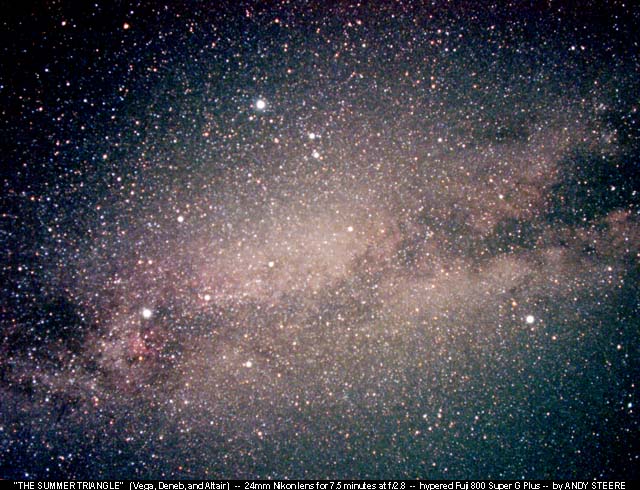Credit & Copyright: Andy Steere
Explanation:
There are more than a few stars in our Galaxy.
The light from many of them combines to appear as a wisp of faint
light across the night sky - the Milky Way.
In the northern hemisphere, away from city lights
and during the summer months, part of the Milky Way
can be seen behind the Summer Triangle
of stars - Deneb,
Vega,
and Altair.
These are the brightest three stars in the above photograph,
listed from left to right, respectively. If you could collect
light in your eyes for 10 minutes at a time (instead of the usual
1/10th of a second), you might see something like the
above photograph.
Behind the Summer Triangle
lies some of the vast star fields
of our Milky Way Galaxy, containing
literally billions
of stars. The dark band across the middle that seems to divide
the stars is actually interstellar dust,
which absorbs more visible light than it emits and so appears
dark.
1999 2000 2001 2002 2003 2004 2005 2006 2007 2008 2009 2010 2011 2012 2013 2014 2015 2016 2017 2018 2019 2020 2021 2022 2023 2024 2025 |
Январь Февраль Март Апрель Май Июнь Июль Август Сентябрь Октябрь Ноябрь Декабрь |
NASA Web Site Statements, Warnings, and Disclaimers
NASA Official: Jay Norris. Specific rights apply.
A service of: LHEA at NASA / GSFC
& Michigan Tech. U.
|
Публикации с ключевыми словами:
Summer Triangle - Milky Way - Вега - Млечный Путь - плоскость Галактики - Межзвездная пыль
Публикации со словами: Summer Triangle - Milky Way - Вега - Млечный Путь - плоскость Галактики - Межзвездная пыль | |
См. также:
Все публикации на ту же тему >> | |
